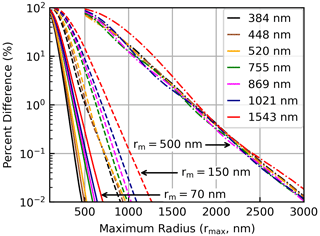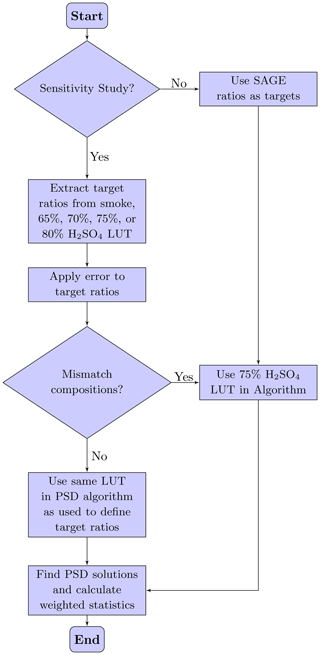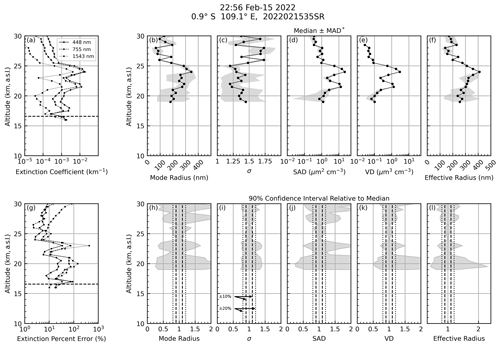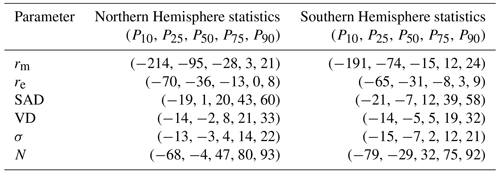the Creative Commons Attribution 4.0 License.
the Creative Commons Attribution 4.0 License.
Characterization of stratospheric particle size distribution uncertainties using SAGE II and SAGE III/ISS extinction spectra
Mahesh Kovilakam
Larry Thomason
Stephen J. Miller
A new algorithm was developed to infer particle size distribution parameters from the Stratospheric Aerosol and Gas Experiment II (SAGE II) and SAGE III on the International Space Station (SAGE III/ISS) extinction spectra using a lookup table (LUT) approach. Here, the SAGE-based extinction ratios were matched to LUT values, and, using these matches, weighted statistics were calculated to infer the median particle size distribution values and higher-moment parameters as well as quantify the uncertainty in these estimates. This was carried out by solving for both single-mode and bimodal lognormal distributions. The work presented herein falls under two general headings: (1) a theoretical study was carried out to determine the accuracy of this methodology, and (2) the solution algorithm was applied to the SAGE II and SAGE III/ISS records with a brief case study analysis of the 2022 Hunga Tonga eruption. This methodology was demonstrated to be ≈ 25 % accurate for mode radius and has a minor dependence on particle composition. While bimodal solutions were obtained from this algorithm, we provide a conclusive demonstration of how and why these estimates are inherently unstable using SAGE III/ISS extinction spectra alone. Finally, we demonstrated how the Hunga Tonga aerosol plume evolved in regard to both size and transport over 18 months after the 2022 Hunga Tonga eruption. The particle size distribution (PSD) estimates, higher-moment parameters, and uncertainties are new products within the SAGE III/ISS Level 2 (L2) products, are currently available for download, and will be merged into the main SAGE III/ISS release products in a subsequent L2 release.
- Article
(17706 KB) - Full-text XML
- BibTeX
- EndNote
Stratospheric aerosols play a key role in determining the chemistry (Hofmann and Solomon, 1989; Fahey et al., 1993; Solomon et al., 1996) and radiative balance (Minnis et al., 1993; Ridley et al., 2014) of the atmosphere. Recent changes in the stratospheric aerosol loading (since 2000) have received significant attention in the scientific community (Hofmann et al., 2009; Vernier et al., 2011; Ridley et al., 2014; Santer et al., 2014; Vernier et al., 2015; Solomon et al., 2011; Bourassa et al., 2012). Many global climate models (GCMs) rely on observational data to represent stratospheric aerosols as these GCMs do not have an interactive stratospheric aerosol scheme to model aerosol properties (Kremser et al., 2016). An accurate representation of stratospheric aerosol properties including particle size distribution (PSD) is therefore important. While there have been other global stratospheric aerosol measurements available since the early 1980s, the Stratospheric Aerosol and Gas Experiment (SAGE) series of satellites (McCormick et al., 1979) has provided a long-term (1979–2005; 2017–present), multi-wavelength, global record of stratospheric aerosols. To date, data collected by the SAGE family of instruments have been instrumental in improving our understanding of chemistry, radiative balance, and atmospheric dynamics (Lu et al., 2000; Fadnavis et al., 2013; Dube et al., 2020).
The second SAGE instrument (SAGE II) collected data between 1985 and 2005, and the current SAGE instrument on the International Space Station (SAGE III/ISS) began collecting data in June 2017. The measurement method of all SAGE instruments has been occultation: peering through Earth's atmosphere to observe how the solar spectrum changes as a function of altitude. This allows for retrieval of altitude-dependent number densities for gas-phase species (e.g., O3, NO2, H2O) as well as a series of aerosol extinction coefficients (referred to, hereafter, as extinction), which have an expected precision on the order of ≈ 5 %–10 % (NASA, 2018). The extinction spectra (i.e., how extinction changes as a function of wavelength) contain limited information regarding composition (Knepp et al., 2022) as well as the microphysical properties (e.g., particle size distributions) for the aerosol responsible for attenuating the Sun's light (von Savigny and Hoffmann, 2020; Wrana et al., 2021, 2023). These microphysical properties play a key role in regulating atmospheric chemistry (Hofmann and Solomon, 1989; Fahey et al., 1993; Solomon et al., 1996) and radiative balance (Minnis et al., 1993; Ridley et al., 2014) in GCMs. Indeed, extinction spectra have been used to infer aerosol surface area density (SAD) and effective radius (re) for the SAGE II instrument (Thomason et al., 1997, 2008; Damadeo et al., 2013), which was released as a standard product for that dataset. However, despite the high level of precision in the aerosol extinction product, the utility of the SAD product was predominantly limited to deriving SAD in the wake of volcanic events since, during background conditions, the uncertainty in the SAD product was potentially > 200 % (Thomason et al., 2008). While SAD and re were released as part of the SAGE II product, PSD parameters (e.g., mode radius and distribution width) have never been part of the standard SAGE product. To date, external groups have been responsible for developing their own algorithms and methodologies for extracting this information from the extinction spectra (e.g., Wang et al., 1989a, b, 1996; Yue, 2000; Bingen et al., 2004a; Wrana et al., 2021, 2023). Such inferences are challenging and inherently unstable due to the ill-posedness of the problem (Fussen et al., 2001). One method to stabilize the solution space is to apply a smoothness condition that forces the PSD parameters to vary smoothly with altitude (Bingen et al., 2004a, b, 2006, 2017). While this methodology tends to produce reasonable values, it has not been evaluated to determine its accuracy or precision. Indeed, validating these products by comparison to in situ observations (e.g., from aircraft field campaigns or balloon flights) would be challenging. The challenge in performing “traditional” validation exercises (e.g., involving aircraft and balloon campaigns) that compare these derived products with in situ observations comes primarily from differing sampling volumes. As an occultation measurement, the SAGE instrument peers through hundreds of kilometers of atmosphere as the instrument scans across the solar disk. Therefore, the question becomes how representative the in situ measurements of the total sampling volume of the SAGE instrument are. Generally speaking, such intercomparisons often gloss over this by assuming that the zonal variability in the observed species, over short timescales, is sufficiently low so as to allow for intercomparison. While this has proven effective in validating ozone (Wang et al., 2020), similar treatment with aerosol has yet to consistently yield agreement better that 35 % (Deshler et al., 2003) due, in part, to the differing sampling volumes and atmospheric heterogeneity.
An alternative to validating the inferred PSD parameters using empirical data is to gauge the potential accuracy of these methods by working in the other direction. By starting with Mie theory, where the microphysical properties are strictly defined, we can create lookup tables of extinction coefficients at SAGE wavelengths for varying combinations of PSD parameters. These lookup tables can then be used to identify all PSD parameters that yield matches to a series of SAGE-observed extinction coefficients (within the precision of the measurement). This will effectively provide the solution space of PSD and microphysical properties for SAGE extinction products. Ultimately, this results in a collection of PSD parameters for each SAGE profile, with a quantified error for the PSD estimate. This methodology is described below and is applied to the SAGE II and SAGE III/ISS record. The influence of common assumptions are discussed throughout the paper.
The SAGE family instruments have been described previously (Mauldin et al., 1985; Cisewski et al., 2014). Briefly, SAGE instruments use the solar occultation method to measure the solar attenuation, as a function of wavelength, which occurs throughout the atmosphere. Standard products include the number density of gas-phase species (e.g., O3, NO2, and H2O) as well as aerosol extinction coefficients (385, 450, 525, and 1020 nm for SAGE II and 384, 448, 520, 601, 676, 755, 869, 1021, and 1543 nm for SAGE III/ISS; referenced as kλ). Herein, the SAGE II v7.0 and SAGE III/ISS v5.3 (June 2017–November 2023, inclusive) products were used. Analysis was limited to altitudes between the tropopause and 30 km, and the 601 and 676 nm channels were excluded from the analysis due to ozone interference within those channels (Wang et al., 2020).
Computing hardware and code
The analysis code was written in Python and relied heavily on the PyTorch (v1.12.1) library. Because of the nature of the lookup table (LUT) methodology and the data volume, extensive parallelization was required to run the code within a reasonable amount of time. This requirement was most pronounced during the bimodal analysis. Therefore, all of the solution routines as well as the statistical calculations were carried out on an NVIDIA A100 GPU with 80 GB of memory. While the 80 GB of memory within the A100 was required for the bimodal analysis, we note that all of the single-mode solution code could be run on a more modest GPU. Indeed, much of the development work was carried out on a Quadro RTX 3000.
3.1 Lookup table construction
In this section we present a brief overview of the theoretical basis for constructing the LUTs as well as justification for the PSD boundaries used in generating these tables.
The processing time of this algorithm is directly related to the size of the LUTs. Further, the resolution and extent of the PSD parameters used to generate the LUTs directly controls the accuracy of the inferred PSD parameters. This creates a dilemma: do we sacrifice accuracy for an improved runtime or improve the accuracy at the cost of runtime? Therefore, after providing a general overview of the LUT creation we present brief justifications for the parameters and resolutions used herein.
Extinction coefficients at each SAGE wavelength (kλ) were calculated using Mie theory under the assumption that all particles are spherical and the distribution is single-mode lognormal. This was done for sulfuric acid aerosol at different weight percents (65 %, 70 %, 75 %, and 80 % sulfuric acid by weight with water comprising the rest of the particle) using refractive indices reported by Palmer and Williams (1975), smoke composed of black carbon (BC) using refractive indices reported by Sumlin et al. (2018), and smoke composed of brown carbon (BrC) using refractive indices reported by Bergstrom et al. (2002). These refractive indices are presented in Table 1.
Table 1Complex refractive indices for sulfuric acid and smoke used in the Mie calculations. The smoke refractive index values were based on data reported in Bergstrom et al. (2002) for BC and Sumlin et al. (2018) for BrC. Sulfuric acid refractive index values are from Palmer and Williams (1975).

The PSD LUTs were generated by first calculating single particle extinction efficiencies (Qext(λ,r), where λ was an array of SAGE wavelengths and r was an array of particle radii (here, nm); for derivation of Qext(λ,r), see Kerker, 1969; Hansen and Travis, 1974, or Bohren and Huffman, 1983). The extinction coefficients were then calculated by multiplying Qext with a series of single-mode lognormal distributions (P(rm,σ); here, the number density (N) was set to 1 cm−3) followed by integration (Eq. 1). The lognormal distribution is described in Eq. (2), where σ is the geometric standard deviation (sometimes written σg in the aerosol literature and hereafter referred to as distribution width) and rm is the mode radius (the median radius of a lognormal distribution is commonly referred to as mode radius in aerosol literature; we adopt this convention here). Lognormal distributions were calculated for mode radii (rm) that extended from 10 nm through 1500 nm (1 nm resolution) and distribution widths that ranged from 1.01 through 2.0 with a resolution of 0.001. This resulted in three-dimensional lookup tables of extinction coefficients (i.e., ) as a function of incident light wavelength, mode radius, and distribution width.
Because the resolution and the range of particle radii and distribution widths used to create extinction tables play a critical role in defining the accuracy of the LUTs and the corresponding PSD parameters inferred from these LUTs, we provide a brief justification for the resolution and range of rm and σ below.
3.1.1 Justification for the extent of particle radii
The extent of particle radii used to create the extinction efficiency table as well as set the integration boundaries (rmin and rmax in Eq. 1) was based on the influence large particles can have, despite their rarity, on the overall extinction. As an example, three lognormal distributions (rm = 100 nm, ) are presented in Fig. 1. Here, it is observed that the distribution is Gaussian in log space and that as the radius gets farther from rm, the corresponding probability decreases rapidly. What is not obvious from Fig. 1 is that larger particles, despite having a probability equal to the smaller particles, have a disproportionate influence on extinction. The reason behind this disparity is the competing extinction efficiencies as shown in Fig. 2, wherein it is observed that large particles (e.g., 1 µm) are ≈ 3 orders of magnitude more efficient at attenuating light than a 70 nm particle. Logically, one can infer that one large particle can attenuate light as efficiently as 100–1000 smaller particles; therefore, large particles, however rare, cannot be ignored when building the LUTs.
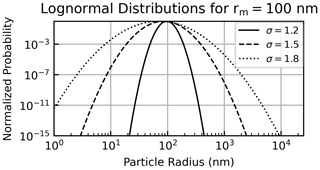
Figure 1Example lognormal distributions for three distribution widths () for a mode radius of 100 nm.
As a further demonstration of the importance of large particles we carried out a series of simulations to demonstrate the impact that changing the upper integration boundary (rmax) in Eq. (1) has on k(λ). Here, Qext was calculated for all radii between 10 nm and 10 µm (1 nm resolution), followed by the integration of Eq. (1) using different upper integration boundaries (k(λ,rmax)). This model was carried out using three different mode radii ( nm) and a single distribution width (σ=1.5). Extinction coefficients were calculated as a function of the upper integration boundary of Eq. (1) (k(λ,rmax)), and we calculated the percent difference between these values and the value of k(λ) when 10 µm (i.e., k(λ,10 µm)). The results of this model are presented in Fig. 3, wherein it is observed that if the desired accuracy for k(λ) is 1 % for all channels, then rmax must be > 525 nm when rm= 70 nm, > 1 µm for rm= 150 nm, and > 2.4 µm when rm= 500 nm. While changes in σ and/or rm will modulate the limit of rmax required to achieve 1 % accuracy, the general observation remains the same: choosing a value of rmax that is too small will invariably bias k(λ) as well as the inferred PSD values. Therefore, to obviate the impact of this bias we set rmax to 10 µm.
3.1.2 Justification for the resolution of distribution widths
The influence that the resolution of the distribution width (Δσ) had on k(λ) was evaluated as a function of rm and Δσ as shown in Fig. 4. Here, it was observed that if σ= 1.5 (Fig. 4b), rm= 75 nm (i.e., background conditions of the fine mode per Deshler et al., 2003), and the resolution of the LUT (Δσ) is 0.01, then the corresponding bias in k(λ) is ≈ 5 %. It was observed that the σ resolution has less impact as rm and σ increased. However, in order to mitigate the bias introduced by Δσ we used a resolution of in creating the LUTs. This resolution introduces a bias in k(λ) on the order of 1 % under small-particle (75 nm) conditions, which we treat as negligible in the subsequent analysis. We note that in reality, size distributions are likely bimodal and the impact of the larger mode on extinction cannot be ignored as discussed below (e.g., Sect. 4.4). However, neglect of the coarse mode, with respect to the current discussion of Fig. 4, results in an overestimation of the LUT-resolution-induced error. Therefore, the percent differences in Fig. 4 are representative of upper bounds.

Figure 4Influence of the distribution width resolution on the corresponding extinction coefficient error. The wavelength used in this simulation was 520 nm. The horizontal dashed line represents the typical background particle size for the fine mode (75 nm).
Justification for the selection of the range of σ cannot be explained with a single figure. Rather, the range of σ was defined based on the results of a series of sensitivity tests that are described more fully in Sect. 4. Briefly, part of the sensitivity tests involved varying the range of PSD parameters used in LUT creation (see Table 2). It was determined that extending the LUT σ and rm ranges to 2.0 and 1500 nm, respectively, yielded the best performing solutions when compared to theoretical data (see Sect. 4 for an expanded discussion of the corresponding sensitivity study).
3.2 Inferring PSD parameters
3.2.1 Historical background
The necessity of using extinction ratios, as opposed to extinction coefficients, for eliminating the influence of number density (N) and inferring aerosol physical parameters has been discussed previously (e.g., Thomason et al., 1997; Bingen et al., 2006; Wrana et al., 2021). Therefore, the method of determining the atmospheric PSD parameters is straight forward and requires only searching through the LUTs to identify all PSD parameters that yield extinction ratios that match extinction ratios from the SAGE records to within the bounds of the reported uncertainty. Indeed, if measurement error was negligible, then the PSD parameters could be inferred to a high degree of accuracy. However, this level of precision is never achieved outside possibly laboratory settings, and making such simplifying assumptions is fundamentally flawed. Indeed, the fundamental limitation of inferring PSD parameters from instruments like SAGE is the under-constrained nature of the problem, which results in a plethora of potential solutions.
As an illustration of the problem, LUT data were used to plot two extinction ratios against each other (Fig. 5a). Nominal extinction ratios and their corresponding uncertainties (0.3±15 %, 1.2±10 %) were included as a representative SAGE data point (the red dot in Fig. 5). All LUT data that fall within the SAGE error limits are valid solutions (herein we refer to these values as “within the solution space”). Since the rm and σ values for each LUT value is known, we can identify all rm and σ combinations that fall within the solution space. The range and relative frequency of these values are plotted as normalized probability density functions in Fig. 5b and c. Here, it is observed that, within the bounds of uncertainty, the range of rm was [160,360] nm and the range of σ was [1.25,1.8). While adding more extinction ratio combinations and decreasing the measurement uncertainty decreases the extent of the solution space, this simple example demonstrates the problem inherent in inferring PSD parameters from SAGE data: multiple solutions. Therefore, the breadth of the solution space demands the following question be answered: which PSD values are either correct, most likely, or most representative of reality?

Figure 5Visualization of the variability in rm and σ within the error bars (b, c) and along the edges of the error limits (d, e). The errors were fixed at 15 % and 10 % along the x and y axes, respectively. The dashed red lines in panel (a) represent the solution space for the nominal SAGE value. The vertical dashed lines in panels (b)–(e) represent the target rm and σ values that correspond to the red dot in panel (a).
A previous method published by Wrana et al. (2021) answered this by using the PSD values that fell closest to the SAGE ratios as the solution (i.e., the closest match). They went on to estimate the error in these PSD values by sampling at eight locations along the error boundaries, as defined by the propagated errors, and calculating the mean difference between these peripheral PSD values and those that correspond to the closest match. The challenge in this method is the highly variable nature of the PSD values that lay along these boundaries as shown in Fig. 5d and e. Therefore, the error estimate is highly dependent on where samples are drawn along the error boundaries.
The key points of Fig. 5 are that the central point is not necessarily a good estimate of the PSD parameters, that there is a non-negligible amount of variability in the PSD parameters within the overall solutions space, and that accurate error estimates cannot be calculated by sampling along the edge of the solution space. The method presented herein attempts to overcome these limitations.
3.2.2 Solutions from SAGE data
The overall flow of the solution algorithm is depicted schematically in Fig. 6. In short, extinction ratios were calculated and uncertainties were propagated using extinction coefficients from SAGE data (for a detailed discussion of wavelength selection, see Sect. 4). Corresponding extinction ratios were calculated using the LUT data. Similar to the example provided in Fig. 5a, the SAGE ratios were then used to find all of the LUT ratios that fell within the propagated uncertainty as well as the corresponding PSD parameters (i.e., rm and σ). While Fig. 5a only shows two dimensions (i.e., one dimension per extinction ratio), the dimensionality of that figure increases as the number of extinction ratios increases, leading to a simultaneous solution in all dimensions. As discussed above, it is important to recall that finding the closest match in extinction ratios and extracting the corresponding PSD parameters is not sufficient because all LUT ratios that fall within the propagated measurement uncertainty are actual matches to the SAGE ratios. Therefore, a method for estimating the PSD values, given the range of values within the solution space, had to be developed. Here, we used all of the PSD values within the solution space to calculate weighted statistics (e.g., mean, median, percentiles) of the PSD parameters in an attempt to provide a statistical representation of the solution space and thereby provide a better quantification of the uncertainty in the PSD estimates.
The weights used in calculating the weighted statistics were calculated using the probability density function of a multivariate normal distribution as described by Eq. (3), where x is the array of LUT extinction ratios that fell within the solution space, μ is the array of SAGE extinction ratios, Σ is the covariance matrix, and n is the number of dimensions (i.e., combinations of extinction ratios) of the system. The diagonal terms in Σ were composed of the propagated uncertainties from the SAGE data.
The construction of Σ for Eq. (3) requires additional explanation. The covariance matrix is composed of both variances (i.e., the diagonal terms) and covariances (i.e., the off-diagonal terms that represent the degree of correlation between channels). While it is known that the variances in the SAGE extinction products are correlated, as can be can be demonstrated by calculating the coefficient of correlation between the reported errors, quantification of the covariance is not currently possible. While we cannot quantify the covariance terms, we do know that the covariance will be between 0 and (here, u and v represent the uncertainties in each channel) per the Cauchy–Schwartz inequality as shown in Eq. (4). While inclusion of the covariance terms did not significantly change the results, a good-faith estimate of covariance was attempted by setting them to mid-range values of .
3.2.3 Calculation of N and higher-moment parameters
The PSD parameters that fell within the solution space were used to calculate higher-moment parameters listed in Table 3. The generalized moment equation for a lognormal distribution is shown in Eq. (5), where mi is the ith raw moment and N is the particle number density. Per Eq. (5), these calculations require knowledge of N. Following the method of Wrana et al. (2021), we used the PSD parameters within the solution space to calculate corresponding extinction coefficients at 1020 nm (assuming a number density of 1 cm−3) and divided the measured k1020 value by these calculated values. As can be readily seen from Eqs. (1) and (2), this ratio results in N. Finally, all of the N, rm, and σ values within the solution space were evaluated to calculate the parameters listed in Table 3 followed by the calculation of weighted statistics for these parameters as described above.
Table 3Description of higher-moment parameters that were calculated using the inferred PSD parameters and Eq. (5).

4.1 Composition is correctly assumed
Before applying this method to the SAGE records we sought to evaluate the accuracy and consistency of this method for inferring PSD values. This was achieved, from a theoretical perspective, by using LUT data and involved four overall steps.
-
Select extinction coefficients from the LUT. These coefficients, which have known PSD parameters, act as the pseudo-SAGE data.
-
Impose a nominal uncertainty upon the pseudo-SAGE extinction coefficients, calculate the extinction ratios, and propagate the errors. Here, the errors were held constant across all wavelengths and the evaluation was repeated for errors that ranged from 1 % through 50 %.
-
Run the pseudo-SAGE extinction ratios through the solution algorithm to calculate the inferred PSD statistics. Here, the algorithm uses the same LUT from which the pseudo-SAGE extinction coefficients were pulled in step 1.
-
The inferred PSD parameters were compared to the input values to determine how well the two matched.
The overall flow of the algorithm is depicted schematically in Fig. 6. This evaluation was repeated for a series of extinction ratio combinations (see Table 4) and LUT boundary conditions (Table 2) to determine which combination yielded the most accurate results.
Table 4Condition definitions and wavelength assignments for extinction coefficient ratios used in the current study. The asterisk indicates the wavelength combination used in Wrana et al. (2021).

Based on the results of this evaluation we determined that condition no. 5 (Table 4) and particle parameter setting no. 1 (Table 2) yielded the best overall performance. This is not surprising as this condition used all of the available channels, which takes advantage of all of the information content available in the SAGE data. The results of this simulation are seen in Fig. 7, where the inferred-to-target ratios were plotted for three different error values (i.e., 50 %, 20 %, and 5 % error) as a function of the inferred PSD value. The horizontal red lines in Fig. 7 indicate median values, the boxes extend from percentiles P25 to P75, and the whiskers indicate P5 and P95. Here, we chose to plot the inferred-to-target ratio as a function of the inferred PSD parameter because this is most applicable to real-world use cases (i.e., where the “real” or target value is unknown). For example, if the reported errors in the extinction coefficients were all within 5 % and the inferred mode radius was 100 nm then, per Fig. 7c, we know that on median the inferred mode radius is ≈ 5 % too high and that 90 % of the time the inferred value is within ±15 % of the target value.
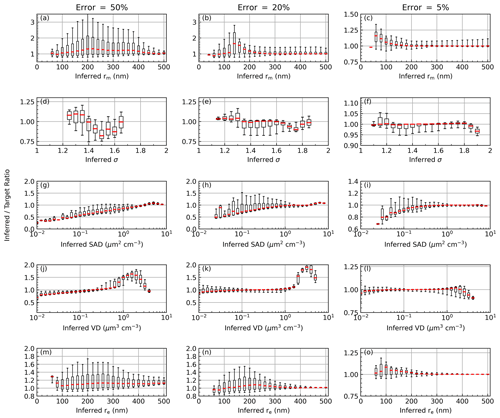
While the performance of condition no. 5 was optimal, it can significantly reduce the number of SAGE extinction spectra that yield a viable PSD inference (see Fig. 8a and d). This is caused by two related issues: (1) shorter-wavelength channels attenuate higher in the atmosphere and result in extinction ratios that fall outside the LUTs' range, and (2) using so many channels increased the chance of having a negative extinction coefficient (Kovilakam et al., 2023) or an otherwise invalid value (e.g., set to “fill” values). A similar combination of extinction ratios that excluded the 384 nm channel was evaluated (condition no. 6). While the performance of condition no. 6 was comparable to that of condition no. 5, there was a noticeable decrease in accuracy (not shown). Further, excluding the 384 nm channel alone did not significantly increase the data volume as shown in Fig. 8. While excluding the 384 nm channel yielded more solutions at lower altitudes, the failure rate remained > 30 % at mid-latitudes (Fig. 8b and e). As a final test we evaluated the performance of a condition definition that used only three channels (no. 15, Fig. 8c and f). This wavelength combination resulted in valid PSD estimates for more than 90 % of its data at all altitudes and latitudes. Figure 8 also shows the performance of these three conditions when only the highest-quality SAGE data were used (i.e., when the reported error was ≤ 20 %; Fig. 8d–f), which did not significantly change the data throughput.
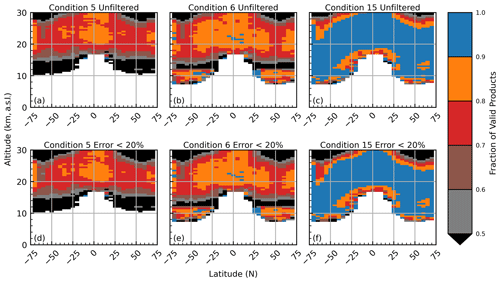
Figure 8Zonal representation of the fraction of SAGE data that yielded PSD estimates. Panels (d)–(f) display the statistic when data with errors greater than 20 % were removed. The fraction was calculated by dividing the number of successful PSD estimates by the total number of SAGE extinction spectra within a given altitude and latitude bin.
The wavelength combinations used by Wrana et al. (2021) (condition no. 15 in Table 4) had the third best overall performance (see Fig. 9) and had the added benefit of only relying on three extinction channels, which resulted in a major improvement in data retention (see Fig. 8c and f). While this condition lacked the overall accuracy of condition nos. 5 and 6, we determined that its performance was acceptable for use as an alternate within this method. Therefore, the results of this evaluation indicate that if we work strictly within the confines of theory, then condition no. 5 is the optimal choice. However, applying this method to reality (i.e., where we must account for measurement uncertainty, the possibility of saturating channels, etc.) we conclude that condition no. 15 is the optimal choice. This puts us on the horns of a dilemma where we are forced to choose our concession: do we sacrifice latitude and altitude coverage for improved accuracy (condition no. 5) or sacrifice accuracy for improved coverage (condition no. 15)? While further discussion on the resolution of this dilemma is outside the scope of this section, we will state that a hybrid model that involves a combination of condition nos. 5, 6, and 15 was used in the application to the SAGE data, and the reader is directed to Sect. 6 for further discussion.
In summary, the general observation of Figs. 7 and 9 is that the accuracy of the PSD solutions became better as the measurement uncertainty decreased and as the input PSD parameters become more like an enhanced event (e.g., larger rm, enhanced SAD). While this is encouraging, it must be recognized that this simulation is only theoretical in nature and that the more challenging aspects of real-world aerosol compositions (e.g., mixed composition particles, multimodal distributions) and PSD parameters have been neglected. To help address these limitations we evaluated the impact of assuming a wrong composition below.
4.2 Impact of assuming wrong sulfuric acid content
To this point we have neglected to account for varying aerosol compositions and how making the incorrect assumption about the composition may influence the inferred PSD parameters. In this section we present the results of a simulation wherein we evaluated the impact of assuming the wrong weight percent of H2SO4. Because H2SO4 is typically assumed to be 75 %, we use that as the point of reference.
Figure 10 demonstrates the overall impact of assuming an incorrect weight percent of H2SO4 in the PSD algorithm. Here, the algorithm searched through the 75 % H2SO4 LUT to find all extinction ratios within the solution space, whereas the pseudo-SAGE extinction ratios were pulled from the 65 %, 70 %, and 80 % H2SO4 LUTs (see Fig. 6 for workflow and Table 1 for refractive indices).
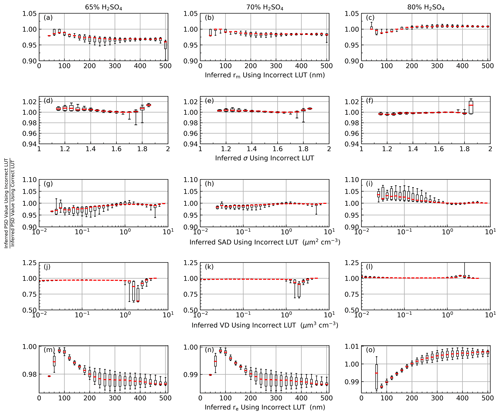
Figure 10Visualization of the impact of getting the weight percent of H2SO4 incorrect. The presented data came from condition no. 5 with an imposed extinction coefficient error of ±20 %.
The y axes in Fig. 10 represent the ratio of the inferred PSD parameter when the LUTs were mismatched to the inferred PSD parameters when the LUTs were correctly matched (i.e., both the extinction ratio and algorithm LUTs were 75 % H2SO4). What this tells us is how much an incorrect assumption about the H2SO4 weight percent changes the inferred PSD parameters as compared to Figs. 7 and 9 (i.e., how much worse these estimates are as compared to getting the composition correct). The extinction coefficient errors used to create Fig. 10 were set to 20 %. Indeed, the spread in the inferred PSD parameters narrowed with decreasing error, and the 20 % error solutions are presented as a representative example.
The general observation from Fig. 10 is that making incorrect assumptions about the aerosols' H2SO4 content has minimal impact on the inferred distribution widths (all were within ≈ 1 %–2 % as compared to Fig. 7), and the inferred rm was most impacted (within ±5 %). These deviations were compounded in the inferred SAD and volume density (VD) products, which deviated by < 8 %.
We note that overall the influence of incorrect H2SO4 assumptions was consistent across all condition definitions (Table 4) with only minor variations. We conclude that incorrect assumptions about the H2SO4 content had a minor impact on the accuracy of the inferred PSD parameters (generally within ±5 %). Since the H2SO4 content of atmospheric aerosols is, ultimately, unknown we note that this situation adds an unknown element to the analysis. However, this uncertainty can be partially mitigated by using concurrent water vapor and temperature observations to estimate H2SO4 content at thermodynamic equilibrium (Steele and Hamill, 1981; Bernath et al., 2023) and will be a topic of study for future releases of this product.
4.3 Impact of assuming a smoke-free atmosphere when smoke is present
The performance of the PSD algorithm was evaluated to determine its accuracy in estimating PSD parameters when the atmosphere is assumed to consist solely of 75 % H2SO4 when it really has smoke. As stated above, smoke is challenging to model because of the ambiguity in its composition and physical properties (e.g., refractive index). While recent work indicates that stratospheric smoke may be consistent in composition and size distribution (Thomason and Knepp, 2023), there have been no in situ observations to determine the composition and physical properties of stratospheric smoke. Therefore, we conducted the following simulation under the assumption that most smoke is composed of brown carbon (BrC) with little contribution from black carbon (BC) and used the refractive indices of Sumlin et al. (2018) and Bergstrom et al. (2002) for BrC and BC, respectively (refractive index values in Table 1).
This simulation followed the same methodology as in Sect. 4.2 but used the smoke LUTs as the extinction ratio targets (see flow in Fig. 6). Here, we assumed that 90 % of the particles were composed of 75 % H2SO4 with rm= 75 nm and σ = 1.5 and that 10 % of the particles were composed of smoke of various compositions. The labels in Fig. 11 indicate the relative breakdown of the smoke particles between BrC and BC.
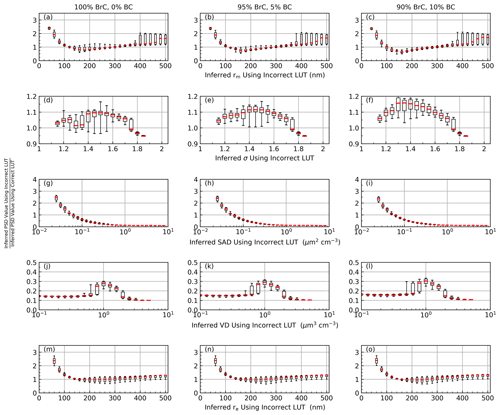
Figure 11Visualization of the impact of assuming a smoke-free atmosphere when smoke is present. The presented data came from condition no. 15 with an assumed extinction coefficient error of ±20 %.
While σ was consistently high the deviation in rm was minimized when the inferred rm was between 100 and 400 nm. This falls in an ideal location as previous studies have shown that pyroCb-related (pyrocumulonimbus) smoke particles are typically between 125 and 250 nm (Moore et al., 2021; Katich et al., 2023). While these studies were conducted in the troposphere (Katich et al., 2023, sampled near the Arctic lower stratosphere), we take them to be representative of stratospheric values for this study, though we recognize that additional in situ sampling would be highly beneficial. Finally, we note that both SAD and VD were significantly underestimated under reasonable values (e.g., when SAD ≥ 0.1 µm2 cm−3), but these discrepancies effectively canceled out in the calculation of re. Given these considerations, we must provide a cautionary note when using data that may be contaminated by the presence of smoke.
4.4 Influence of a second mode: an optical particle counter (OPC) case study
Expanding the solution space from single-mode to bimodal distributions greatly expands the number of possible solutions (see Sect. 5 for additional discussion) and expands the number of variables to solve for. This makes visualization and interpretation of the results challenging. Therefore, we limit this section to a higher-level demonstration that provides the reader with a general understanding of the implications of incorrectly assuming single-mode distributions. To aid in this we used the University of Wyoming's optical particle counter (UWY OPC) record, which provides bimodal PSD parameters at 0.5 km resolution (Deshler, 2023). This record consists of 150 profiles that were collected over Laramie, WY (41.3° N, 105.58° W), between 1989 and 2019 and include observations in the wake of major eruptions such as Mt. Pinatubo (1991) and Raikoke (2019). The OPC PSD parameters were used to calculate extinction coefficients at SAGE wavelengths (see Eq. 1) under two conditions: (1) using only the first mode and (2) using both modes. These OPC-based extinction coefficients were used to create pseudo-SAGE extinction ratios, which were then fed into the PSD solution algorithm, which still used a single-mode lognormal distribution LUT. The uncertainty in the extinction coefficients was fixed to a highly conservative value of 5 % (Deshler et al., 2003). Herein the aerosol composition was set to 75 % H2SO4.
4.4.1 Only using the first OPC mode to calculate extinction
The OPC-based extinction coefficients were calculated using only the first mode in the OPC data followed by running these extinction coefficients through the PSD inference algorithm. This effectively tests the algorithm's performance when the number of modes in the atmospheric aerosol distribution matches the number of modes in the LUT.
Figure 12a–f demonstrate how the inferred PSD parameters and microphysical properties compared to those reported in the OPC record. Here, the inferred values were divided by the reported OPC values for comparison and the shaded region represents the median ±1.4826 times the median absolute deviation (MAD*). The median and MAD statistics are statistically robust alternatives to the mean and standard deviation and are less susceptible to impact from outliers (Leys et al., 2013). Further, when MAD is multiplied by 1.4826, it is roughly equivalent to 1 standard deviation (Leys et al., 2013).
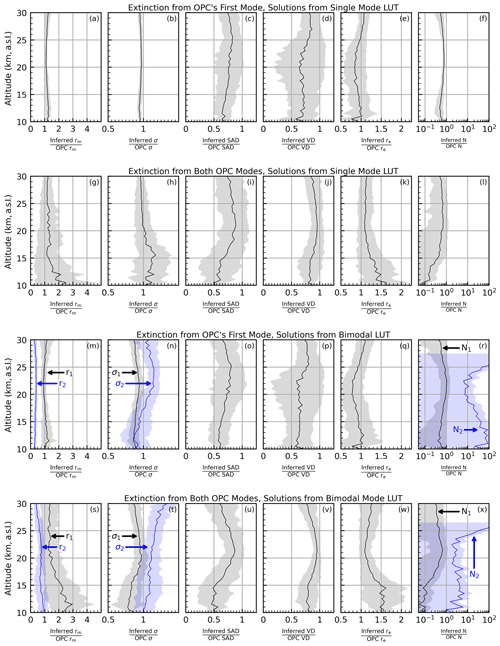
Figure 12Solution profiles of the inferred PSD parameters and microphysical properties referenced to the reported OPC value. The solid lines represent the median ratio, and the shaded regions represent the median ± MAD*. The uncertainty imposed on the extinction coefficients was fixed at 5 %.
It was observed that the inferred rm was consistently overestimated by up to ≈ 30 % (on median), though the agreement became better towards the middle stratosphere (20–25 km). The distribution width provided the best agreement, while the SAD and VD were consistently underestimated by ≈ 25 %. This resulted in an underestimation of effective radius (re) on the order of ≈ 10 %–20 %. These results are consistent with the initial single-mode evaluation (Figs. 7 and 9). Therefore, we conclude that if the atmosphere's aerosol is distributed within a single-mode lognormal distribution and the LUT is likewise single-mode lognormal, then the performance remained consistent with the previous theoretical evaluations. The remaining question is how the performance changes if the atmosphere's aerosol distribution is bimodal.
4.4.2 Using both OPC modes to calculate extinction
The analysis was repeated using both OPC modes to calculate the pseudo-SAGE extinction coefficients that were fed into the PSD inference algorithm. We reiterate that the solution algorithm is still searching for solutions within single-mode lognormal LUTs. This tests the viability of inferring representative single-mode PSD parameters when the atmosphere has aerosol that has a bimodal distribution.
The results of this analysis are seen in Fig. 12g–l, wherein a stark change from the results in panels (a)–(f) is observed. Here, the inferred rm, σ, and N were referenced to the first mode values reported in the OPC record. It was observed that addition of the second mode significantly increased the inferred rm, σ, and VD. Overall, this also increased re, especially at low altitudes, though the middle-stratosphere performance remained comparable to that observed in panel (e). Finally, addition of the second mode reduced the inferred number density by up to a factor of 10 at low altitude (panels f, l).
While a change in performance was not unexpected, the degree of influence the second mode had on the inferred PSD parameters may not be intuitive, especially when one considers the relative paucity of larger-mode particles (OPC number density ratio profiles are shown in Fig. 13d for reference; see also additional discussion below). To understand this one must recall the disproportionate influence large particles have on the overall extinction as shown in Fig. 2. This is further illustrated in Fig. 13, where panel (a) shows the second mode's contribution to the overall extinction as a function of the second mode's rm (labeled r2) for three different wavelengths (385, 520, 1020 nm) and two number density ratios ( and ). Figure 13b shows the second mode's contribution to overall extinction as a function of number density ratios for the same three wavelengths with the following PSD parameters: r1 = 75 nm, σ1 = 1.45, r2 = 310 nm, and σ2 = 1.05 (median values from the OPC record). Panels (c) and (d) aid in interpreting panels (a) and (b) by presenting quartile profiles for r2 and the number density ratio as calculated from the OPC record.

Figure 13Fraction of the total extinction that comes from the larger mode. Panel (a) plots this fraction as a function of the second-mode radius (r2) for three wavelengths and two different number density ratios. Panel (b) plots this fraction as a function of number ratio for three wavelengths using constant bimodal PSD parameters (text inset within the figure). Panels (c) and (d) present the quartile profiles, from the OPC record (see text for details), for the r2 and number density ratio, respectively.
What is first observed in Fig. 13a is a rapid increase in the second mode's contribution to the overall extinction as particle size increases, particularly at the longer wavelengths. However, the shorter wavelengths show an interesting behavior in that their extinction increased rapidly, followed by a flattening and slight decrease in extinction, which is subsequently followed by another rapid increase (this is a product of resonances in the Mie scattering, notably when r2 equalled an integer multiple of λ). Indeed, the longer-wavelength data demonstrate this same behavior, though not on the scale of this figure. The cause of this flattening is a combination of the extinction efficiency for the specified particle as well as the width of the lognormal distribution that was applied prior to integration. For example, if rm falls near the peak in the efficiency curve and the distribution width is sufficiently narrow, then the integrated efficiency (or extinction) will be effectively constant as rm changes. Therefore, where this flattening occurs on the x axis of Fig. 13a depends not only on σ but also on the wavelength and how the number densities are allocated between the two modes.
This figure also demonstrates that at middle-stratospheric conditions (20–25 km), where r2≈ 350 nm (panel c) and (panel d), the second mode accounts for between ≈ 35 % (λ= 384 nm) and ≈ 85 % (λ= 1020 nm) of the overall extinction. Further, panel (d) shows that, in the OPC record, N2:N1 varied between and from ≈ 14–25 km. This variation in number density results in the second mode contributing between 5 % (λ= 384 and ) and ≈ 75 % (λ= 1020 and ) of the overall extinction. Therefore, this simulation demonstrates how sensitive the SAGE extinction spectrum can be to larger particles even when these particles are outnumbered 1000:1. This results in an inevitable bias in not only our PSD algorithm but also all algorithms that use SAGE, as well as SAGE-like, data to infer PSD parameters. Indeed, it is for this reason that the inferred PSD parameters in Fig. 12g–l were larger than those in panels (a)–(f). We reiterate that the degree of this bias is dependent on numerous factors and urge caution in trying to disentangle this information. Ultimately this adds an additional challenge to inferring PSD parameters from SAGE data, one that cannot be fully resolved without incorporation of additional information from other instruments.
The solution algorithm discussed above was expanded to accommodate a bimodal solution space. Inclusion of the second mode is particularly intriguing in light of the discussion in Sect. 4.4.2. A complicating factor in moving to bimodal distributions is that number density cannot be completely ignored. Indeed, the dimensionality of the LUTs must be expanded not only to account for the second rm and σ values but also to account for the relative distribution of particles across the first and second modes. This expands the number of PSD parameters that were used to create the LUTs from two (rm and σ) to six (r1,2, σ1,2, N1,2) and results in an overall expansion in the size of the LUTs. For example, if the bimodal LUTs were constructed using the same limits and resolutions that were used in the single-mode analysis, then the LUT would expand from ≈ 41.6×106 values (≈ 160 MB at 32-bit precision) to more than 1.7×1015 values (≈ 7 PB at 32-bit precision; this number assumes a single ratio of N1 to Ntotal). Therefore, the bimodal LUT limits and resolutions were reduced to accommodate these issues as shown in Table 5. The limits of these parameters were informed by the PSD parameters reported by the UWY OPC record (excluding data collected between 1 June 1991 and 1 June 1997 to remove the impact of the Mt. Pinatubo eruption). The OPC-based statistical profiles are presented in Fig. 14 for reference.
Table 5Range and resolution of PSD parameters used in creating the bimodal LUTs.
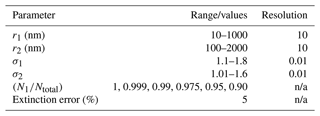
n/a: not applicable.

Figure 14Profiles of PSD parameters as reported in the University of Wyoming's OPC record. Data collected between 1 June 1991 and 1 June 1997 were excluded to remove the influence of the 1991 eruption of Mt. Pinatubo. The shaded regions indicate the median ± MAD*.
Similar to the single-mode sensitivity study (Sect. 4) the bimodal LUTs were tested to determine the feasibility of accurately identifying all six PSD parameters (r1,2, σ1,2, N1,2). We recognize that the limitations on the range and resolution of PSD values in these LUTs inevitably influenced the accuracy of these results (see Sect. 3.1.1 and 3.1.2 for discussion). Further, we recognize that these limits do not cover the full range of PSD values reported within the UWY OPC record. Indeed, if the shaded regions in Fig. 14 were expanded to cover 90 % of the reported values instead of the median ± MAD* then the range of values would have been substantially larger. Therefore, we explicitly state that, as constructed, this simulation is not designed to be applicable to the full range of possible atmospheric conditions. Rather, we defined the boundaries of this model using reasonable values that cover the majority of PSD values as reported in the UWY OPC record. Further, the intent of this bimodal test is not to determine, necessarily, how accurately the inferred bimodal PSD values are, but it is to determine the stability of operating within this expanded solution space.
5.1 OPC case study
The OPC record was used to evaluate the performance of the bimodal solution algorithm in a manner similar to that discussed in Sect. 4.4, and the results are shown in Fig. 12m–x. Figure 12m–r show the results when the pseudo-SAGE extinction coefficients were calculated using only the first-mode PSD parameters from the OPC data (i.e., tests the performance when the atmospheric aerosol is single mode but the solution algorithm uses a bimodal LUT). The reader may question how the second-mode ratios of panels (m) and (n) were calculated if the OPC-generated extinction spectra only used the first OPC mode. Here, the inferred PSD parameters were divided by the first mode of the OPC data. While this may seem nonsensical, this depiction is important for two reasons. First, the difference between the r1 and r2 curves in panel (m) (and the σ1 and σ2 curves in panel n) demonstrate that the solution algorithm does not try to force both modes on top of each other (i.e., r1≠r2 and σ1≠σ2). The inferred modes are distinct from each other. Second, this shows that the inferred first-mode parameters are in better agreement with the first mode of the OPC data (i.e., the mode that was used to generate the pseudo-SAGE extinction spectra). This demonstrates that the solution algorithm does not try to force all of the spectral information into the second mode and, consequently, minimize the first mode. In general, this is a demonstration that the algorithm is performing as intended. Finally, Fig. 12s–x show the results when the pseudo-SAGE extinction coefficients were calculated using both OPC modes (i.e., tests the performance when both the atmospheric aerosol and the solution algorithm LUT are bimodal).
Here, it is observed that mismatching the number of modes in the LUT and atmospheric aerosol distribution had a modest impact on the estimate of r1 and σ1, though r2 was underestimated by ≈ 90 %. This resulted in a highly unreliable estimate of the second mode's number density (N2, panel r). While the corresponding SAD and VD estimates were underestimated, this resulted in an inferred re that was within ≈ 25 % of the OPC value (on median) throughout the profile. Overall, this model indicates that the bimodal solution algorithm provides reasonable estimates for r1 and re despite the pseudo-SAGE extinction coefficients being built off aerosols from a single-mode distribution.
A stark change in performance was observed when the pseudo-SAGE extinction coefficients were created using both OPC modes (panels s–x). Here, r1 was consistently overestimated by ≥25 % throughout the profile, while r2 fell much closer to the 1:1 line. The overestimation of r1 is in agreement with the discussion in Sect. 4.4.2. While the overestimation of N2 is not as severe as in panel (r), the algorithm continued to overestimate N2 by a factor of ≈ 5 and N1 is now underestimated throughout much of the profile. This translates into an overall improvement of the SAD and VD parameters, and re were within 25 % above 17 km. Ultimately this demonstrates how the second mode dominates the performance of the solution algorithm.
5.2 Instability of bimodal solutions from a theoretical perspective
The stability of the bimodal solutions was evaluated in a manner similar to that discussed in Sect. 4. Extinction coefficients were extracted from the LUT for each combination of PSD parameters in Table 6 and then put into the bimodal solution algorithm to calculate the inferred PSD parameters. It is worth noting that while the range and resolution of PSD values that were used to extract extinction coefficients from the LUT (Table 6) were reduced, the overall range and resolution of the LUT used to find solutions were consistent with values in Table 5.
Table 6Range and resolution of target values that were fed into the bimodal solution algorithm for stability testing.
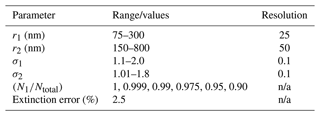
n/a: not applicable.
Visualization of the performance in bimodal space is challenging because of the number of variables. However, the stability of these results can be elucidated by looking at summary statistics and comparing with the results of the single-mode study. These statistics are presented in Table 7.
Table 7Mode radius solution percentiles for the single-mode and bimodal distributions. The percentiles (Pi) indicate the range of target radii that resulted in the indicated inferred radius. Asterisks indicate values that are limited by the range of target values in the model (see Table 6). The uncertainty in k was fixed at 5 %.
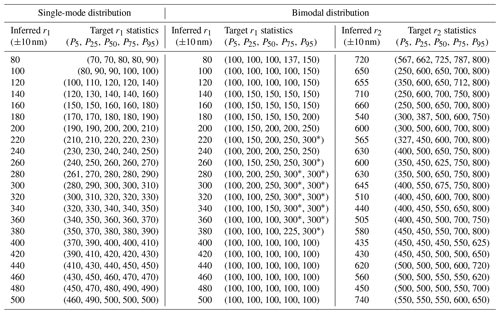
Here, the data were binned according to the inferred r1 for both the single-mode and bimodal solutions. To build this table we took, for example, all PSD parameters that resulted in an inferred r1 of 100 nm and calculated percentile statistics (i.e., P5, P25, P50, P75, P95). Therefore, when the algorithm infers an r1 of 100 nm for a single-mode distribution, we are 90 % confident that the true (target) value is between 80 and 100 nm (this is in agreement with the results of Sect. 4). Indeed, throughout the “Single-mode distribution” column of Table 7 the inferred r1 and target r1 values were in good agreement (generally within ≈ 10 %), demonstrating the stability and accuracy of this method when solving for single-mode parameters.
The bimodal solutions are presented in a similar manner but include details about the second mode. For example, it is possible to infer an r1 of 100 nm when the true (target) value of r1 ranges from 100–150 nm and when the true value of r2 ranges from 250–800 nm (the high degree of variability in the target r2 statistics is driven by the varying number density ratios). Overall, the inferred r1 values are in good agreement with the median target values (i.e., the output matches the input) until the inferred r1 exceeded 300 nm. As seen in Table 6 the biggest r1 value we used as input for the solution algorithm was 300 nm, so any inferred r1 greater than 300 nm should be unexpected. Further, it is interesting to note that in Table 7 the inferred r1 continued to increase even when the target radius remained small, especially as the inferred r1 approached 500 nm. This seemingly unexpected result is due to the presence of larger particles within the second mode dominating the extinction (as discussed in Sect. 3.1.1 and shown in Fig. 13) and thereby opening the solution space to nonsensical values. However, it is important to note that while the irrationality of these results is obvious under controlled simulations, we would have no basis for rejecting these results under real-world conditions. Therefore, we view this as a conclusive demonstration of potentially significant instability in the bimodal solution when the second mode's particles are large, demonstrating the infeasibility of accurately inferring bimodal PSD parameters from SAGE data.
5.3 Recommendations for bimodal solution space
The analysis presented in this section demonstrated that bimodal PSD parameters can be inferred from the SAGE extinction spectra and a casual interpretation of Fig. 12 could lead one to conclude that the situation is hopeful. However, this subsection is presented to remove ambiguity on the interpretation of the bimodal evaluation.
First, moving to a bimodal solution space comes at an additional computational cost. Indeed, despite reducing the LUTs' PSD ranges and resolutions, as compared to the single-mode LUTs, the overall runtime increased by more than 2 orders of magnitude. Therefore, this raised an obvious question: are bimodal solutions worth the increased runtime? To address this the reader is encouraged to note the similarity between panels (g)–(l), where single-mode PSD parameters were inferred, and panels (s)–(x), where bimodal PSD parameters were inferred in Fig. 12. While the bimodal solutions tended to yield a narrower range of solutions (i.e., the shaded regions are narrower in panels s–x), the overall similarity in the median profiles is striking. This indicates that using a bimodal solution space did not significantly improve the overall accuracy of these solutions.
Second, we demonstrated that the second mode has a disproportionate impact on the first mode's estimation. While the overall influence of the second mode, and the corresponding statistics in Table 7, can be modulated by varying distribution widths, number densities, and composition (e.g., what if the first mode is 125 nm smoke particles and the second mode is 400 nm sulfuric acid particles?), the overall interpretation is clear: while the OPC analysis looks promising, the theoretical evaluation in Table 7 demonstrates that there is not enough information within the SAGE extinction spectra to sufficiently constrain the solution space to accurately infer bimodal PSD parameters. Based on these results we conclude that the cost of inferring bimodal PSD parameters is high and the benefit is, at best, modest and recommend against using bimodal PSD solutions based solely on SAGE data.
Since this paper is concerned primarily with the algorithm development and performance, we will not perform an in-depth scientific investigation of any particular event. Rather, herein we explain the details of the application of this algorithm to the SAGE II and SAGE III/ISS missions and provide a high-level overview of the PSD parameters for these missions. The intention here is to provide the reader with a general overview of the performance of this algorithm and the variability in the PSD parameters over the lifetime of these instruments. Having established the methodology, more targeted scientific analyses will be the subject of subsequent publications.
6.1 SAGE II
The PSD algorithm was applied to data collected under the SAGE II mission using only the 520:1021 nm extinction ratio (i.e., condition no. 0 in Table 4) to infer single-mode lognormal distribution parameters. The 384 nm channel was excluded following the guidance of Damadeo et al. (2013), and the 448 nm channel was not included as it is relatively close to the 525 nm channel and did not significantly improve the performance. As shown above (i.e., Figs. 7 and 9) the accuracy of the inferred PSD values is inversely proportional to the measurement uncertainty. Therefore, extinction coefficients with uncertainty of > 20 % were excluded from the analysis. Further, a simple cloud filter was applied, following Thomason and Vernier (2013), by excluding all extinction ratios ≤ 1.4 (we note that cloud filtering did not impact the aggregate statistics shown below).
The reported k1020, median inferred PSD parameters, and median inferred microphysical properties during the SAGE II time period are presented in Figs. 15 and 16 (Northern Hemisphere and Southern Hemisphere, respectively). Notable volcanic eruptions, as defined in Table 8, are indicated with labels above panel (a) in both figures as well as vertical dashed lines within each panel. Here, it is observed that the record was dominated by two major events: the 1982 eruption of El Chichón and the 1991 eruption of Mt. Pinatubo. Both eruptions resulted in bimodal aerosol distributions (Knollenberg and Huffman, 1983; Oberbeck et al., 1983; Deshler et al., 1992, 1993, 2003), which means that the inferred PSD parameters will be heavily weighted toward the coarser mode as discussed in Sect. 4.4. However, the general observation within these figures is that these eruptions led to overall larger particles (including re), enhanced SAD, enhanced VD, and enhanced N.

Figure 15Extinction coefficient (k1020), median inferred PSD parameters, and median inferred microphysical properties for SAGE II data collected in the Northern Hemisphere. The data were filtered to remove extinction coefficients that had an uncertainty in excess of 20 % or were indicative of cloud contamination (i.e., ).
Table 8Notable volcanic and pyroCb events during the SAGE II and SAGE III/ISS records. Table includes labels used to identify events in Figs. 15, 16, 18, 19, and 22.
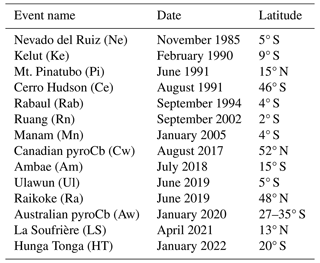
The SAGE II v7.0 product files contained SAD and re estimates as described in Thomason et al. (2008) and Damadeo et al. (2013). Thomason et al. (2008) provided a detailed discussion on the uncertainty in the inferred SAD values, which is generally within ±30 % in the main aerosol layer but may have an overall range in excess of 200 % under light aerosol loads. The agreement between the current algorithm's SAD and re products, as compared to the v7.0 products, is shown in Fig. 17. Data in Fig. 17 were filtered using the same criteria as in Figs. 15 and 16. Here, panels (a) and (d) present normalized histograms of the abundance of the v7.0 SAD and re products, respectively. Panels (c) and (f) present the relative abundance of the percent difference between the current algorithm's SAD and re estimates and the v7.0 values, respectively. Finally, panels (b) and (e) present scatterplots, color-coded by k1020, of the percent difference between the two algorithms vs. the v7.0 SAD and re, respectively.
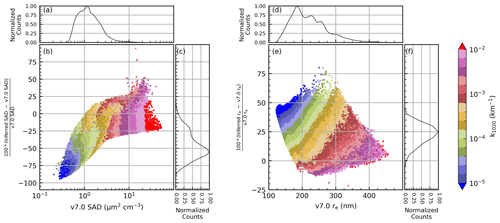
Two general observations are made within Fig. 17: first, as k1020 increased, so too did SAD and re; second, as k1020 increased, the agreement between the two algorithms improved. Further, under enhanced aerosol load (e.g., km−1) the majority of the SAD and re estimates were within the ±30 % uncertainties stated in Thomason et al. (2008). The histograms in Fig. 17 show the relative distribution of these physical parameters as well as the percent difference. It is observed that more than half of the SAD estimates were greater than 1 µm2 cm−3 (panel a) and the re had a broader range (panel d) with four modes at 180, 230, 260, and 300 nm.
Overall, the PSD estimates from SAGE II were comparable to values observed within the OPC record (see, e.g., Deshler et al., 2003), and the SAD and re estimates agree with the v7.0 products within the stated uncertainty under enhanced conditions. While this does not provide definitive validation of this new algorithm, this does demonstrate consistency between this new method and an established product that is currently in use within the community and provides confidence in validity of this technique.
6.2 SAGE III/ISS
As discussed in Sect. 4, a combination of condition definitions were used for identifying the PSD parameters in the SAGE III/ISS record. First, solutions were searched using condition no. 5 (i.e., all channels except those in the Chappuis band). There are several reasons why this condition would fail to deliver valid solutions, all of which relate to the input extinction coefficients. For example, if the reported extinction for any channel is negative or a channel is saturated, then the solution algorithm cannot perform. In the case that a solution is not found using condition no. 5, the algorithm then excludes the 384 nm channel (condition no. 6) and makes another attempt to find solutions. The exclusion of the 384 nm channel is, of course, based on the assumption that the failure of condition no. 5 was due to the 384 nm channel being either negative or saturated. Finally, in the case that condition no. 6 fails to find a solution, the algorithm switches over to condition no. 15 (i.e., the third best performing condition per Sect. 4, data not shown) and makes a final attempt to find the PSD solutions. If no solutions were found in condition no. 15, then no PSD parameters were provided for that particular spectrum. After finding solutions the data were filtered to remove the influence of cloud contamination using the method of Kovilakam et al. (2023). We note that the changes between conditions did not result in step-function-like changes within the PSD profiles.
The results are shown in Figs. 18 and 19 for the Northern Hemisphere and Southern Hemisphere, respectively, for the entire SAGE III/ISS record. The Northern Hemisphere was dominated by the 2017 Canadian wildfire and the 2019 eruption of Raikoke as well as smaller eruptions (e.g., the 2021 eruption of La Soufrière) and transport from larger events that occurred in the Southern Hemisphere (e.g., the 2022 eruption of Hunga Tonga). The Southern Hemisphere was dominated by the 2020 Australian wildfires as well as the 2022 eruption of Hunga Tonga (more discussion below). Indeed, the impact of the Canadian and Australian wildfires persisted for ≈ 1 and ≈ 2 years, respectively. This resulted in estimations of large particles and narrow distribution widths throughout these time periods. However, as discussed above, these results must be interpreted with caution given the uncertain composition, phase, and morphology of smoke particles.
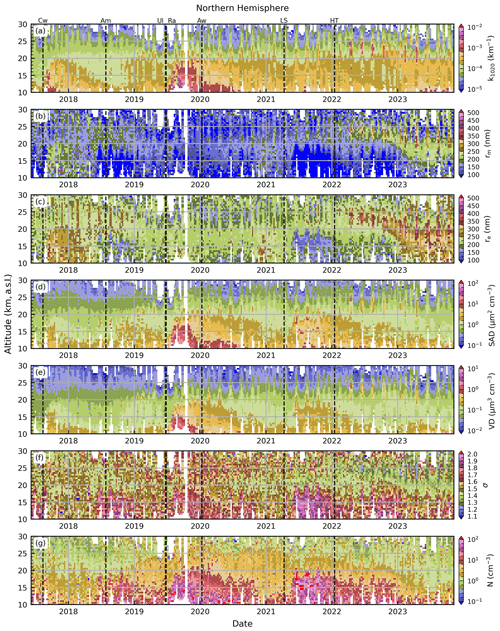
Figure 18Extinction coefficient (1020 nm, a) and size distribution parameters (b–e) inferred over the entire SAGE III/ISS record for the Northern Hemisphere.
Both hemispheres showed a consistent pattern of smaller particles formed immediately after the smaller eruptions (i.e., Ambae, Ulawun, La Soufrière), while the larger eruptions produced larger particles. This small-particle formation was directly correlated with increased number density (panel g) and inversely correlated with the distribution width (panel f). However, the Raikoke and Hunga Tonga eruptions, as well as the major wildfire events, consistently produced larger particles with smaller distribution widths. While these events did not yield number densities comparable to the smaller events, the number densities remained elevated as compared to background conditions. These results are in agreement with previous studies (Thomason et al., 2021; Wrana et al., 2023).
Hunga Tonga case study
We now present a brief demonstration of the algorithm's products in the aftermath of the 2022 eruption of Hunga Tonga. A more thorough scientific evaluation will be the subject of a subsequent publication (in progress). Here, we take the opportunity to finish the presentation of the statistics that are output from this method and do a cursory comparison to balloon-borne optical particle counter observations.
Monthly zonal median plots of the inferred effective radii are presented in Fig. 20, wherein it is observed that the main plume contained particles with re> 400 nm, in March 2022, and this plume was centered near 10° S and 24 km. The plume was transported predominantly southward, though some of the particles were caught in the natural northward circulation. While all particle sizes were transported to lower altitudes as a product of the Brewer–Dobson circulation (especially outside tropical latitudes), the larger particles showed a disproportionately rapid descent, as compared to the smaller particles. This is most readily seen when comparing Fig. 20a–d with Fig. 20e–h where, regardless of latitude, we observed a partitioning between the largest particles (> 400 nm) and smaller particles (< 300 nm) over the ensuing year. Here, the plume of the largest particles was centered at ≈ 20 km near the Equator and descended to lower altitudes toward the higher latitudes. This is in contrast to the persistence of smaller particles at higher altitudes, well past 25 km. Finally, we note the apparent growth of particles with time, predominantly at lower altitudes, where re approached 500 nm in March/June 2023.
The PSD estimates from an individual profile collected on 15 February 2022 are shown in Fig. 21. Before discussing the content of this figure, it is important to recall the method we used in inferring the PSD parameters (i.e., extinction coefficient LUTs were used to identify all theoretical PSD parameters that yielded extinction ratios within the propagated uncertainty in the SAGE III/ISS extinction ratios). This enabled us to provide a statistical representation of the PSD solution space on a point-by-point basis, part of which is the overall spread in the solution space. This statistical representation is presented in Fig. 21, with the spread in the solution space represented by the shaded regions.
Figure 21a contains the extinction coefficient profiles for three wavelengths, and panel (g) contains the percent errors in these coefficients. Panels (b) through (f) contain profiles of the inferred parameters, with the shaded region indicating the median ± MAD*. Panels (h) through (l) contain the 90 % confidence interval (CI) relative to the median (vertical dashed lines are guides to the eye and represent the ±10 % and ±20 % levels).
Three distinct peaks were observed in the extinction profile at 18, 21.5, and 24 km, though the solution algorithm failed to find any PSD parameters that yielded extinction ratios comparable to the SAGE III/ISS values below 19 km. Further, the spread in solution space, due to increased extinction uncertainty (panel g) near 20 km, resulted in less certain PSD estimates. However, the reported uncertainty in the extinction coefficients at 24 km was smaller and resulted in a narrower range of PSD parameter solutions. The estimated mode radius at 24 km was 345 ± 20 nm with a distribution width (σ) of 1.3 ± 0.05. We note that the inferred re value at 24 km (410 ± 5 nm) is in good agreement with the estimate of 460 nm from data collected by a Portable Optical Particle Spectrometer (Asher et al., 2023) as well as other recent independent estimates of re (Khaykin et al., 2022; Legras et al., 2022; Duchamp et al., 2023). In summary, the variability in the extinction profiles correlates well with variability in the PSD, SAD, VD, and re profiles.
The CI statistics are a key feature of this methodology (panels h through l) and provide guidance on the level of confidence of these estimates. For example, looking at the mode radius data at 24 km we conclude that 90 % of the theoretical PSD parameters that matched the SAGE III/ISS extinction ratios (within the bounds of the reported uncertainty) had a mode radius and distribution width that were within 10 % of the inferred median value. A similar statement can be made for the SAD, VD, and re estimates as well. The utility of this method is that this CI estimation opens an opportunity for implementing not only the PSD and microphysical products in chemistry and climate models, but this opens the opportunity for improved uncertainty estimates for the input parameters that drive these models as well as improved uncertainty estimates for the products that come from these models.
6.3 Putting the SAGE II results into perspective
As discussed above, the PSD algorithm was applied to the SAGE II record using the criteria of condition no. 0 (i.e., a single extinction ratio). While the overall qualitative behavior of those results, as shown in Figs. 15 and 16, were reasonable, the question remains as to the quantitative reliability of these estimates. To evaluate this we found the PSD solutions for the SAGE III/ISS data using the criteria of condition no. 0 (hereafter referred to as the “cond0” version) and compared these results with the values calculated using the hybrid condition no. 5–6–15 of Sect. 6.2 (hereafter referred to as the “hybrid” version). The results of this evaluation are presented in Fig. 22 for the Southern Hemisphere.
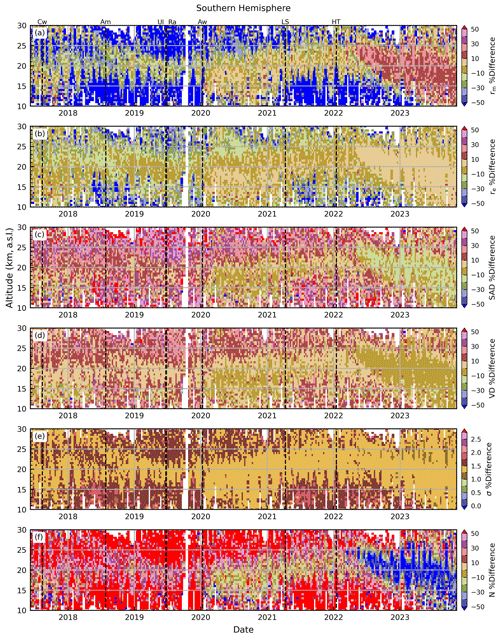
Figure 22Percent difference between PSD products inferred using the hybrid condition no. 5–6–15 and those inferred using only condition no. 0. The percent difference was calculated by taking .
Here, it is observed that the two versions are generally within ≈ 30 % of each other for the higher-moment parameters. The distribution width (σ) had, by far, the best agreement where the entire record was within 2 %. However, the rm estimate had mixed results outside the main aerosol layer. Indeed, the cond0 rm estimates were > 50 % higher than the hybrid estimates for much of that record. Finally, the N estimates for cond0 were notably lower (i.e., larger percent difference) outside the main aerosol layer. We note that these large percent differences were driven by variability of small numbers. While this results in apparent wild fluctuations on a relative scale, the absolute variability is small.
Bulk statistics, which represent both the Northern Hemisphere and Southern Hemisphere, are presented in Table 9. These statistics demonstrate a systematic overestimation in the rm and re estimates, while the SAD, VD, and σ differences had medians closer to 0 and inter-quartile ranges that were within ≈ ±25 % of the median. The overall interpretation of Table 9 and Fig. 22 is that the cond0 estimates are in good agreement with the hybrid results within the main aerosol layer and certainly under elevated aerosol load (e.g., after Hunga Tonga). However, the agreement is notably worse outside elevated aerosol conditions. These results are consistent with the findings of Thomason et al. (2008) regarding their discussion of SAD and re estimates (both of which relied on two wavelengths). While these results are encouraging for estimating post-eruption PSD parameters, we were unable to determine a distinct cutoff in k1020 above which the cond0 estimates were consistently in good agreement with the hybrid products. Finally, while the cond0 products may be useful for observing general trends within the SAGE II record, users must be aware of this product's limitations.
We presented a methodology for inferring particle size distribution (PSD) parameters from SAGE extinction spectra. The novelty of this methodology is in the statistical representation of the PSD solution space, which provides the community with the potential range of PSD and microphysical values as well as the corresponding confidence intervals. While the PSD solutions are valuable for climate and chemistry modeling, the statistical information provides an additional level of information previously not available. Indeed, this additional information allows end users to propagate these uncertainties through their respective calculations and thereby improve the error assessment of their end products.
The accuracy of this method was evaluated in terms of both single-mode and bimodal lognormal distributions as a function of extinction coefficient uncertainty. We demonstrated that the inferred single-mode PSD parameters were within ≈ ±25 % when the extinction error was small (Figs. 7 and 9). Further, we evaluated the impact that incorrect composition assumptions had on the single-mode PSD estimates (Figs. 10 and 11). A key result of this study is that while PSD parameters can be inferred using extinction spectra from instruments such as SAGE, these parameters cannot be represented by a single number (e.g., mean or median). Rather, the extinction spectra, within the bounds of measurement uncertainty, can be reproduced by myriad PSD combinations, and this variability must be reported as done here.
The PSD and microphysical property products were compared to the University of Wyoming's OPC record. Overall the two records were in good agreement.
We studied the feasibility of obtaining bimodal solutions from the SAGE III/ISS spectra alone (Sect. 4.4) and used the University of Wyoming's OPC record as a case study to evaluate the accuracy of these results. While the bimodal solution algorithm returned PSD estimates that were in generally good agreement with the OPC record, this came at the cost of significantly increased computation time and with the caveat that the solution space was heavily biased toward coarse-mode particles (i.e., the algorithm tried to minimize r1 and maximize r2). In effect, the algorithm is forcing all of the finer-mode particles into a regime that SAGE is insensitive to (e.g., ⪅ 150 nm per Fig. 2) so that the fine mode, in effect, could be ignored. Indeed, the coarse-mode particles dominated even when the fine-mode particles outnumbered them by more than 100:1. We provided a detailed discussion regarding the physical reasoning behind this bias. Based on this analysis we concluded that the bimodal solution space is too unstable to provide consistently reliable PSD estimates without incorporating an additional dataset.
PSD values for both the SAGE II and SAGE III/ISS data were obtained for the entire data record, and the variability in these parameters was demonstrated. Herein we showed that the SAGE II record was dominated by events that yielded large particles throughout most of its record, while the SAGE III/ISS record is composed of a mixture of events (volcanic and pyroCb) that resulted in both smaller and larger particles as discussed by Wrana et al. (2023). Our surface area density (SAD) and effective radius (re) estimates for the SAGE II data were compared to the standard SAD and re products within the SAGE II v7.0 product. While the v7.0 products and our products were within the specified uncertainties (i.e., ±30 % under enhanced aerosol load and ±200 % under background conditions per Thomason et al., 2008), the overall agreement was better under enhanced conditions.
The SAGE II PSD parameters were inferred using only a single extinction ratio (condition no. 0), which calls into question the quality of these estimates due to the limited information content of two wavelengths. The performance of condition no. 0 was evaluated by creating PSD estimates from the SAGE III/ISS record using both condition no. 0 (cond0) and the original hybrid of conditions (using condition nos. 5, 6, and 15). Here, it was determined that the cond0 estimates were regularly larger than the hybrid estimates, which led to a skew in the overall distribution.
The SAGE III/ISS PSD parameters, the higher-moment parameters, and the uncertainty estimates represent new SAGE III/ISS Level 2 products and are available to the community for download and use (NASA, 2024). Please see the section “Data availability” for details.
The SAGE data used within this study are available on NASA's Atmospheric Science Data Center (ASDC; https://doi.org/10.5067/ISS/SAGEIII/SOLAR_BINARY_L2-V5.3, NASA/LARC/SD/ASDC, 2024). The SAGE III/ISS PSD parameters are available at NASA's ASDC (NASA, 2024, https://doi.org/10.5067/ISS/SAGEIII/PSD_L2-V1.1) as stand-alone files until they are merged into an upcoming major release of the Level 2 (L2) product. At that point the PSD data will be within the main SAGE III/ISS record and the stand-alone files will no longer be updated.
TNK developed the methodology, wrote the solution algorithm, and wrote the paper. LT and MK aided in interpretation of the results and application to the Hunga Tonga eruption. SJM provided guidance on the algorithm's architecture and optimization. All authors participated in scientific and algorithmic discussions, and all authors reviewed the paper prior to submission.
The contact author has declared that none of the authors has any competing interests.
Publisher’s note: Copernicus Publications remains neutral with regard to jurisdictional claims made in the text, published maps, institutional affiliations, or any other geographical representation in this paper. While Copernicus Publications makes every effort to include appropriate place names, the final responsibility lies with the authors.
This work was funded as part of the SAGE III/ISS Science Team. SAGE III/ISS is a mission managed by NASA Langley and funded by the NASA Science Mission Directorate within the Earth Systematic Missions Program. Enabling partners are the NASA Human Exploration and Operations Mission Directorate, the International Space Station Program, and the European Space Agency. ADNET Systems Inc. personnel are supported through the NASA LaRC RSES contract (no. 80LARC17C003).
The authors would like to express their gratitude to Felix Wana for reading the pre-submitted version of this paper and providing insightful comments that improved this paper prior to submission. The authors would also like to thank Chris Boone and the anonymous reviewers for reviewing this paper and providing actionable feedback regarding the quality and content of the submitted version of this paper. Finally, the authors thank Sandip Dhomse for leading the review of this paper as the handling editor.
This research has been supported by the National Aeronautics and Space Administration (SAGE III/ISS Science Team).
This paper was edited by Sandip Dhomse and reviewed by Chris Boone and two anonymous referees.
Asher, E., Todt, M., Rosenlof, K., Thornberry, T., Gao, R.-S., Taha, G., Walter, P., Alvarez, S., Flynn, J., Davis, S. M., Evan, S., Brioude, J., Metzger, J.-M., Hurst, D. F., Hall, E., and Xiong, K.: Unexpectedly rapid aerosol formation in the Hunga Tonga plume, P. Natl. Acad. Sci. USA, 120, e2219547120, https://doi.org/10.1073/pnas.2219547120, 2023. a
Bergstrom, R. W., Russell, P. B., and Hignett, P.: Wavelength Dependence of the Absorption of Black Carbon Particles: Predictions and Results from the TARFOX Experiment and Implications for the Aerosol Single Scattering Albedo, J. Atmos. Sci., 59, 567–577, https://doi.org/10.1175/1520-0469(2002)059<0567:WDOTAO>2.0.CO;2, 2002. a, b, c
Bernath, P., Boone, C., Pastorek, A., Cameron, D., and Lecours, M.: Satellite characterization of global stratospheric sulfate aerosols released by Tonga volcano, J. Quant. Spectrosc. Ra., 299, 108520, https://doi.org/10.1016/j.jqsrt.2023.108520, 2023. a
Bingen, C., Fussen, D., and Vanhellemont, F.: A global climatology of stratospheric aerosol size distribution parameters derived from SAGE II data over the period 1984–2000: 1. Methodology and climatological observations, J. Geophys. Res.-Atmos., 109, D06201, https://doi.org/10.1029/2003JD003518, 2004a. a, b
Bingen, C., Fussen, D., and Vanhellemont, F.: A global climatology of stratospheric aerosol size distribution parameters derived from SAGE II data over the period 1984–2000: 2. Reference data, J. Geophys. Res.-Atmos., 109, D06202, https://doi.org/10.1029/2003JD003511, 2004b. a
Bingen, C., Fussen, D., and Vanhellemont, F.: A review of stratospheric aerosol characterization, Adv. Space Res., 38, 2433–2445, https://doi.org/10.1016/j.asr.2006.02.061, 2006. a, b
Bingen, C., Robert, C. E., Stebel, K., Brüehl, C., Schallock, J., Vanhellemont, F., Mateshvili, N., Höpfner, M., Trickl, T., Barnes, J. E., Jumelet, J., Vernier, J.-P., Popp, T., de Leeuw, G., and Pinnock, S.: Stratospheric aerosol data records for the climate change initiative: Development, validation and application to chemistry-climate modelling, Remote Sens. Environ., 203, 296–321, https://doi.org/10.1016/j.rse.2017.06.002, 2017. a
Bohren, C. F. and Huffman, D. R.: Absorption and Scattering of Light by Small Particles, Wiley-Interscience, New York, New York, ISBN l0-471-05772-X, 1983. a
Bourassa, A. E., Rieger, L. A., Lloyd, N. D., and Degenstein, D. A.: Odin-OSIRIS stratospheric aerosol data product and SAGE III intercomparison, Atmos. Chem. Phys., 12, 605–614, https://doi.org/10.5194/acp-12-605-2012, 2012. a
Cisewski, M., Zawodny, J., Gasbarre, J., Eckman, R., Topiwala, N., Rodriguez-Alvarez, O., Cheek, D., and Hall, S.: The Stratospheric Aerosol and Gas Experiment (SAGE III) on the International Space Station (ISS) Mission, in: Conference on Sensors, Systems, and Next-Generation Satellites XVIII, Amsterdam, Netherlands, 22–25 September 2014, edited by: Meynart, R., Neeck, S. P., and Shimoda, H., Proceedings of SPIE 9241, SPIE, p. 924107, https://doi.org/10.1117/12.2073131, ISBN 978-1-62841-304-5, ISSN 0277-786X, 2014. a
Damadeo, R. P., Zawodny, J. M., Thomason, L. W., and Iyer, N.: SAGE version 7.0 algorithm: application to SAGE II, Atmos. Meas. Tech., 6, 3539–3561, https://doi.org/10.5194/amt-6-3539-2013, 2013. a, b, c
Deshler, T.: Mid Latitude | University of Wyoming Stratospheric Aerosol Measurements, Version v4, WyoScholar [data set], https://doi.org/10.15786/21534894, 2023. a
Deshler, T., Hofmann, D., Johnson, B., and Rozier, W.: Balloon-Borne Measurements of the Pinatubo Aerosol Size Distribution and Volatility at Laramie, Wyoming During the Summer of 1991, Geophys. Res. Lett., 19, 199–202, https://doi.org/10.1029/91GL02787, 1992. a
Deshler, T., Johnson, B., and Rozier, W.: Balloonborne Measurements of Pinatubo Aerosol During 1991 and 1992 at 41° N: Vertical Profiles, Size Distribution, and Volatility, Geophys. Res. Lett., 20, 1435–1438, https://doi.org/10.1029/93GL01337, 1993. a
Deshler, T., Hervig, M., Hofmann, D., Rosen, J., and Liley, J.: Thirty years of in situ stratospheric aerosol size distribution measurements from Laramie, Wyoming (41° N), using balloon-borne instruments, J. Geophys. Res.-Atmos., 108, 4167, https://doi.org/10.1029/2002JD002514, 2003. a, b, c, d, e
Dube, K., Randel, W., Bourassa, A., Zawada, D., McLinden, C., and Degenstein, D.: Trends and Variability in Stratospheric NOx Derived From Merged SAGE II and OSIRIS Satellite Observations, J. Geophys. Res.-Atmos., 125, e2019JD031798, https://doi.org/10.1029/2019JD031798, 2020. a
Duchamp, C., Wrana, F., Legras, B., Sellitto, P., Belhadji, R., and von Savigny, C.: Observation of the aerosol plume from the 2022 Hunga Tonga – Hunga Ha'apai eruption with SAGE III/ISS, Geophys. Res. Lett., accepted, https://doi.org/10.22541/essoar.168771425.59096731/v1, 2023. a
Fadnavis, S., Semeniuk, K., Pozzoli, L., Schultz, M. G., Ghude, S. D., Das, S., and Kakatkar, R.: Transport of aerosols into the UTLS and their impact on the Asian monsoon region as seen in a global model simulation, Atmos. Chem. Phys., 13, 8771–8786, https://doi.org/10.5194/acp-13-8771-2013, 2013. a
Fahey, D., Kawa, S., Woodbridge, E., Tin, P., Wilson, J., Jonsson, H., Dye, J., Baumgardner, D., Borrmann, S., Toohey, D., Avallone, L. M., Proffitt, M. H., Margitan, J., Loewenstein, M., Podolske, J. R., Salawitch, R. J., Wofsy, S. C., Ko, M. K. W., Anderson, D. E., Schoeber, M. R., and Chan, K. R.: In situ measurements constraining the role of sulphate aerosols in mid-latitude ozone depletion, Nature, 363, 509–514, https://doi.org/10.1038/363509a0, 1993. a, b
Fussen, D., Vanhellemont, F., and Bingen, C.: Evolution of stratospheric aerosols in the post-Pinatubo period measured by solar occultation, Atmos. Environ., 35, 5067–5078, https://doi.org/10.1016/S1352-2310(01)00325-9, 2001. a
Hansen, J. and Travis, L.: Light-Scattering in Planetary Atmospheres, Space Sci. Rev., 16, 527–610, https://doi.org/10.1007/BF00168069, 1974. a
Hofmann, D., Barnes, J., O'Neill, M., Trudeau, M., and Neely, R.: Increase in background stratospheric aerosol observed with lidar at Mauna Loa Observatory and Boulder, Colorado, Geophys. Res. Lett., 36, L15808, https://doi.org/10.1029/2009GL039008, 2009. a
Hofmann, D. J. and Solomon, S.: Ozone destruction through heterogeneous chemistry following the eruption of El Chichon, J. Geophys. Res.-Atmos., 94, 5029–5041, https://doi.org/10.1029/JD094iD04p05029, 1989. a, b
Katich, J., Apel, E., Bourgeois, I., Brock, C., Bui, T., Campuzano-Jost, P., Commane, R., Daube, B., Dollner, M., Fromm, M., Froyd, K. D., Hills, A. J., Hornbrook, R. S., Jimenez, J. L., Kupc, A., Lamb, K. D., McKain, K., Moore, F., Murphy, D. M., Nault, B. A., Peischl, J., Perring, A. E., Peterson, D. A., Ray, E. A., Rosenlof, K. H., Ryerson, T., Schill, G. P., Schroder, J. C., Weinzierl, B., Thompson, C., Williamson, C. J., Wofsy, S. C., Yu, P., and Schwarz, J. P.: Pyrocumulonimbus affect average stratospheric aerosol composition, Science, 379, 815–820, https://doi.org/10.1126/science.add3101, 2023. a, b
Kerker, M.: The Scattering of Light and other electromagnetic radiation, Academic Press, New York, New York, ISBN 0124045502, 1969. a
Khaykin, S., Podglajen, A., Ploeger, F., Grooß, J.-U., Tencé, F., Bekki, S., Khlopenkov, K., Bedka, K., Rieger, L., Baron, A., Godin-Beekmann, S., Legras, B., Sellitto, P., Sakai, T., Barnes, J., Uchino, O., Morino, I., Nagai, T., Wing, R., Baumgarten, G., Gerding, M., Duflot, V., Payen, G., Jumelet, J., Querel, R., Liley, B., Bourassa, A., Clouser, B., Feofilov, A., Hauchecorne, A., and Ravetta, F.: Global perturbation of stratospheric water and aerosol burden by Hunga eruption, Communications Earth & Environment, 3, 316, https://doi.org/10.1038/s43247-022-00652-x, 2022. a
Knepp, T. N., Thomason, L., Kovilakam, M., Tackett, J., Kar, J., Damadeo, R., and Flittner, D.: Identification of smoke and sulfuric acid aerosol in SAGE III/ISS extinction spectra, Atmos. Meas. Tech., 15, 5235–5260, https://doi.org/10.5194/amt-15-5235-2022, 2022. a
Knollenberg, R. G. and Huffman, D.: Measurements of the aerosol size distributions in the El Chichon cloud, Geophys. Res. Lett., 10, 1025–1028, https://doi.org/10.1029/GL010i011p01025, 1983. a
Kovilakam, M., Thomason, L., and Knepp, T.: SAGE III/ISS aerosol/cloud categorization and its impact on GloSSAC, Atmos. Meas. Tech., 16, 2709–2731, https://doi.org/10.5194/amt-16-2709-2023, 2023. a, b
Kremser, S., Thomason, L. W., von Hobe, M., Hermann, M., Deshler, T., Timmreck, C., Toohey, M., Stenke, A., Schwarz, J. P., Weigel, R., Fueglistaler, S., Prata, F. J., Vernier, J.-P., Schlager, H., Barnes, J. E., Antuna-Marrero, J.-C., Fairlie, D., Palm, M., Mahieu, E., Notholt, J., Rex, M., Bingen, C., Vanhellemont, F., Bourassa, A., Plane, J. M. C., Klocke, D., Carn, S. A., Clarisse, L., Trickl, T., Neely, R., James, A. D., Rieger, L., Wilson, J. C., and Meland, B.: Stratospheric aerosol-Observations, processes, and impact on climate, Rev. Geophys., 54, 278–335, https://doi.org/10.1002/2015RG000511, 2016. a
Legras, B., Duchamp, C., Sellitto, P., Podglajen, A., Carboni, E., Siddans, R., Grooß, J.-U., Khaykin, S., and Ploeger, F.: The evolution and dynamics of the Hunga Tonga–Hunga Ha'apai sulfate aerosol plume in the stratosphere, Atmos. Chem. Phys., 22, 14957–14970, https://doi.org/10.5194/acp-22-14957-2022, 2022. a
Leys, C., Ley, C., Klein, O., Bernard, P., and Licata, L.: Detecting outliers: Do not use standard deviation around the mean, use absolute deviation around the median, J. Exp. Soc. Psychol., 49, 764–766, https://doi.org/10.1016/j.jesp.2013.03.013, 2013. a, b
Lu, C.-H., Yue, G. K., Manney, G. L., J ager, H., and Mohnen, V. A.: Lagrangian approach for Stratospheric Aerosol and Gas Experiment (SAGE) II profile intercomparisons, J. Geophys. Res.-Atmos., 105, 4563–4572, https://doi.org/10.1029/1999JD901077, 2000. a
Mauldin, L., Zaun, N., McCormick, M., Guy, J., and Vaughn, W.: Stratospheric Aerosol and Gas Experiment-II Instrument – A Functional Description, Opt. Eng., 24, 307–312, https://doi.org/10.1117/12.7973473, 1985. a
McCormick, M. P., Hamill, P., Pepin, T. J., Chu, W. P., Swissler, T. J., and McMaster, L. R.: Satellite Studies of the Stratospheric Aerosol, B. Am. Meteorol. Soc., 60, 1038–1047, https://doi.org/10.1175/1520-0477(1979)060<1038:SSOTSA>2.0.CO;2, 1979. a
Minnis, P., Harrison, E. F., Stowe, L. L., Gibson, G., Denn, F. M., Doelling, D., and Smith, W.: Radiative climate forcing by the Mount Pinatubo eruption, Science, 259, 1411–1415, https://doi.org/10.1126/science.259.5100.1411, 1993. a, b
Moore, R. H., Wiggins, E. B., Ahern, A. T., Zimmerman, S., Montgomery, L., Campuzano Jost, P., Robinson, C. E., Ziemba, L. D., Winstead, E. L., Anderson, B. E., Brock, C. A., Brown, M. D., Chen, G., Crosbie, E. C., Guo, H., Jimenez, J. L., Jordan, C. E., Lyu, M., Nault, B. A., Rothfuss, N. E., Sanchez, K. J., Schueneman, M., Shingler, T. J., Shook, M. A., Thornhill, K. L., Wagner, N. L., and Wang, J.: Sizing response of the Ultra-High Sensitivity Aerosol Spectrometer (UHSAS) and Laser Aerosol Spectrometer (LAS) to changes in submicron aerosol composition and refractive index, Atmos. Meas. Tech., 14, 4517–4542, https://doi.org/10.5194/amt-14-4517-2021, 2021. a
NASA: Stratospheric Aerosol and Gas Experiment on the International Space Station (SAGE III/ISS): Data Product User's Guide, v2.0, https://asdc.larc.nasa.gov/documents/sageiii-iss/guide/DPUG-G3B-2-0.pdf (last access: 3 September 2020), 2018. a
NASA: SAGE III/ISS PSD database, NASA, https://doi.org/10.5067/ISS/SAGEIII/PSD_L2-V1.1, 2024. a, b
NASA/LARC/SD/ASDC: SAGE III/ISS L2 Solar Event Species Profiles (Native) V053, NASA Langley Atmospheric Science Data Center DAAC [data set], https://doi.org/10.5067/ISS/SAGEIII/SOLAR_BINARY_L2-V5.3, 2024. a
Oberbeck, V. R., Danielsen, E. F., Snetsinger, K. G., Ferry, G. V., Fong, W., and Hayes, D. M.: Effect of the eruption of El Chichon on stratospheric aerosol size and composition, Geophys. Res. Lett., 10, 1021–1024, https://doi.org/10.1029/GL010i011p01021, 1983. a
Palmer, K. and Williams, D.: Optical-Constants of Sulfuric-Acid; Application to Clouds of Venus, Appl. Optics, 14, 208–219, https://doi.org/10.1364/AO.14.000208, 1975. a, b
Ridley, D. A., Solomon, S., Barnes, J. E., Burlakov, V. D., Deshler, T., Dolgii, S. I., Herber, A. B., Nagai, T., Neely III, R. R., Nevzorov, A. V., Ritter, C., Sakai, T., Santer, B. D., Sato, M., Schmidt, A., Uchino, O., and Vernier, J. P.: Total volcanic stratospheric aerosol optical depths and implications for global climate change, Geophys. Res. Lett., 41, 7763–7769, https://doi.org/10.1002/2014GL061541, 2014. a, b, c
Santer, B. D., Bonfils, C., Painter, J. F., Zelinka, M. D., Mears, C., Solomon, S., Schmidt, G. A., Fyfe, J. C., Cole, J. N., Nazarenko, L., Taylor, K. E., and Wentz, F. J.: Volcanic contribution to decadal changes in tropospheric temperature, Nat. Geosci., 7, 185–189, https://doi.org/10.1038/NGEO2098, 2014. a
Solomon, S., Portmann, R. W., Garcia, R. R., Thomason, L. W., Poole, L. R., and McCormick, M. P.: The role of aerosol variations in anthropogenic ozone depletion at northern midlatitudes, J. Geophys. Res.-Atmos., 101, 6713–6727, https://doi.org/10.1029/95JD03353, 1996. a, b
Solomon, S., Daniel, J. S., Neely, R. R., Vernier, J.-P., Dutton, E. G., and Thomason, L. W.: The persistently variable “background” stratospheric aerosol layer and global climate change, Science, 333, 866–870, https://doi.org/10.1126/science.1206027, 2011. a
Steele, H. M. and Hamill, P.: Effects of temperature and humidity on the growth and optical properties of sulphuric acid–water droplets in the stratosphere, J. Aerosol Sci., 12, 517–528, https://doi.org/10.1016/0021-8502(81)90054-9, 1981. a
Sumlin, B. J., Heinson, Y. W., Shetty, N., Pandey, A., Pattison, R. S., Baker, S., Hao, W. M., and Chakrabarty, R. K.: UV–Vis–IR spectral complex refractive indices and optical properties of brown carbon aerosol from biomass burning, J. Quant. Spectrosc. Ra., 206, 392–398, https://doi.org/10.1016/j.jqsrt.2017.12.009, 2018. a, b, c
Thomason, L., Poole, L., and Deshler, T.: A global climatology of stratospheric aerosol surface area density deduced from stratospheric aerosol and gas experiment II measurements: 1984–1994, J. Geophys. Res.-Atmos., 102, 8967–8976, https://doi.org/10.1029/96JD02962, 1997. a, b
Thomason, L. W. and Knepp, T. N.: Quantifying SAGE II (1984–2005) and SAGE III/ISS (2017–2021) observations of smoke in the stratosphere, EGUsphere [preprint], https://doi.org/10.5194/egusphere-2023-995, 2023. a
Thomason, L. W. and Vernier, J.-P.: Improved SAGE II cloud/aerosol categorization and observations of the Asian tropopause aerosol layer: 1989–2005, Atmos. Chem. Phys., 13, 4605–4616, https://doi.org/10.5194/acp-13-4605-2013, 2013. a
Thomason, L. W., Kovilakam, M., Schmidt, A., von Savigny, C., Knepp, T., and Rieger, L.: Evidence for the predictability of changes in the stratospheric aerosol size following volcanic eruptions of diverse magnitudes using space-based instruments, Atmos. Chem. Phys., 21, 1143–1158, https://doi.org/10.5194/acp-21-1143-2021, 2021. a
Thomason, L. W., Burton, S. P., Luo, B.-P., and Peter, T.: SAGE II measurements of stratospheric aerosol properties at non-volcanic levels, Atmos. Chem. Phys., 8, 983–995, https://doi.org/10.5194/acp-8-983-2008, 2008. a, b, c, d, e, f, g
Vernier, J.-P., Fairlie, T. D., Natarajan, M., Wienhold, F. G., Bian, J., Martinsson, B. G., Crumeyrolle, S., Thomason, L. W., and Bedka, K. M.: Increase in upper tropospheric and lower stratospheric aerosol levels and its potential connection with Asian pollution, J. Geophys. Res.-Atmos., 120, 1608–1619, https://doi.org/10.1002/2014JD022372, 2015. a
Vernier, J. P., Thomason, L. W., Pommereau, J. P., Bourassa, A., Pelon, J., Garnier, A., Hauchecorne, A., Blanot, L., Trepte, C., Degenstein, D., and Vargas, F.: Major influence of tropical volcanic eruptions on the stratospheric aerosol layer during the last decade, Geophysi. Res. Lett., 38, L12807, https://doi.org/10.1029/2011GL047563, 2011. a
von Savigny, C. and Hoffmann, C. G.: Issues related to the retrieval of stratospheric-aerosol particle size information based on optical measurements, Atmos. Meas. Tech., 13, 1909–1920, https://doi.org/10.5194/amt-13-1909-2020, 2020. a
Wang, H. J. R., Damadeo, R., Flittner, D., Kramarova, N., Taha, G., Davis, S., Thompson, A. M., Strahan, S., Wang, Y., Froidevaux, L., Degenstein, D., Bourassa, A., Steinbrecht, W., Walker, K. A., Querel, R., Leblanc, T., Godin-Beekmann, S., Hurst, D., and Hall, E.: Validation of SAGE III/ISS Solar Occultation Ozone Products With Correlative Satellite and Ground-Based Measurements,J. Geophys. Res.-Atmos., 125, e2020JD032430, https://doi.org/10.1029/2020JD032430, 2020. a, b
Wang, P., McCormick, M., Swissler, T., Osborn, M., Fuller, W., and Yue, G.: Inference of Stratospheric Aerosol Composition and Size Distribution from SAGE-II Satellite Measurements, J. Geophys. Res.-Atmos., 94, 8435–8446, https://doi.org/10.1029/JD094iD06p08435, 1989a. a
Wang, P., Kent, G., McCormick, M., Thomason, L., and Yue, G.: Retrieval analysis of aerosol-size distribution with simulated extinction measurements at SAGE III wavelengths, Appl. Optics, 35, 433–440, https://doi.org/10.1364/AO.35.000433, 1996. a
Wang, P.-H., McCormick, M. P., McMaster, L. R., Chu, W. P., Swissler, T. J., Osborn, M. T., Russell, P. B., Oberbeck, V. R., Livingston, J., Rosen, J. M., Hofmann, D. J., Grams, G. W., Fuller, W. H., and Yue, G. K.: SAGE II aerosol data validation based on retrieved aerosol model size distribution from SAGE II aerosol measurements, J. Geophys. Res.-Atmos., 94, 8381–8393, https://doi.org/10.1029/JD094iD06p08381, 1989b. a
Wrana, F., von Savigny, C., Zalach, J., and Thomason, L. W.: Retrieval of stratospheric aerosol size distribution parameters using satellite solar occultation measurements at three wavelengths, Atmos. Meas. Tech., 14, 2345–2357, https://doi.org/10.5194/amt-14-2345-2021, 2021. a, b, c, d, e, f, g
Wrana, F., Niemeier, U., Thomason, L. W., Wallis, S., and von Savigny, C.: Stratospheric aerosol size reduction after volcanic eruptions, Atmos. Chem. Phys., 23, 9725–9743, https://doi.org/10.5194/acp-23-9725-2023, 2023. a, b, c, d
Yue, G.: Retrieval of aerosol size distributions and integral properties from simulated extinction measurements at SAGE III wavelengths by the linear minimizing error method, J. Geophys. Res.-Atmos., 105, 14719–14736, https://doi.org/10.1029/2000JD900165, 2000. a







